Unité de Catalyse et de Chimie du Solide site Artois
Faculté des Sciences de Lens
PUBLICATIONS MARQUANTES 2012
:
- 7 publications [à Facteur d'impact > 5]
- «Cooperativity in Aqueous Organometallic Catalysis: Contribution of Cyclodextrin-Substituted Polymers»
J. Potier, S. Menuel, D. Fournier, S. Fourmentin, P. Woisel, E. Monflier, F. Hapiot
ACS Catalysis, 2012, 2, 1417-1420 - doi: 10.1021/cs300254t - IF = 5,27
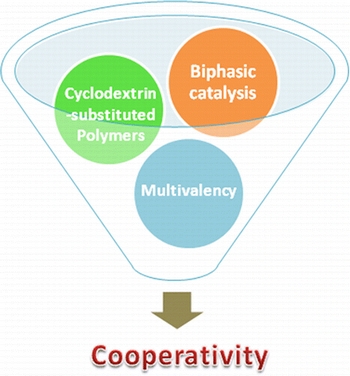 |
| Cooperativity has been implicated to explain the catalytic performances of cyclodextrin-substituted polymers in aqueous rhodium-catalyzed hydroformylation of 1-hexadecene, thus opening the door to the transformation of very hydrophobic substrates in aqueous biphasic catalysis by supramolecular means. |

- «Stability limit of the layered-perovskite structure in Ln2Ti2O7 (Ln=Lanthanide) thin films grown on (110)-oriented SrTiO3 substrates by sol-gel route»
Z. Shao, S. Saitzek, P. Roussel, R. Desfeux
J. Mater. Chem., 2012, 22 (47), 24894 - 24901 - doi: 10.1039/C2JM34729F - IF = 5,97
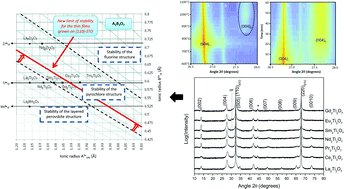 |
| The stability limit between the layered-perovskite and pyrochlore structures was investigated for Ln2Ti2O7 (Ln = lanthanide) thin films grown on (110)-oriented SrTiO3 substrate by the sol–gel route. In bulk, for standard conditions of pressure and temperature, these oxides adopt the layered-perovskite structure for Ln = La to Nd while they crystallize in the pyrochlore one for Sm to Lu. When grown in thin films on (110)-oriented SrTiO3 substrates, the frontier separating these two structures is shifted. High-resolution X-ray diffraction measurements evidence the stabilization of a metastable (00l) oriented layered-perovskite structure for Sm2Ti2O7, Eu2Ti2O7 and Gd2Ti2O7. Such stabilization is explained by a combination of both the strains induced by the substrate in the film and the good lattice match between the substrate and the metastable layered-perovskite oxide. The stabilization of layered-perovskite structures in thin films opens interesting perspectives in terms of development of new ferroelectric/piezoelectric devices, keeping in mind that the isostructural La2Ti2O7 and Nd2Ti2O7 possess a very high Curie temperature (Tc ≈ 1500 °C). Finally, the role played by the lanthanide precursor (nitrate or chloride) in the stabilization of the layered-perovskite structure is highlighted and prediction for stabilization of other new layered-perovskite compounds in the Ln2B2O7 (B = Zr, Mn) system for thin films deposited on the (110)-oriented SrTiO3 substrate is reported. |

- «Cyclodextrin/Amphiphilic Phosphane Mixed Systems and their Applications in Aqueous Organometallic Catalysis»
M. Ferreira, H. Bricout, N. Azaroual, D. Landy, S. Tilloy, Fr. Hapiot, E. Monflier
Adv. Synth. Catal. 2012, 354, 1337-1346 - doi : 10.1002/adsc.201100837 - IF = 6,05
|
| When mixed with a water-soluble phosphane capable of self-assembling into micelles, native or modified β-cyclodextrins (β-CDs) show very contrasting behavior depending on their neutral or ionic nature. In the post-micellar region, neutral β-CDs led to a micelle destructuring. Conversely, micelles remained stable over a well-defined range of ionic β-CD concentrations. In that case, the micelle destruction was only observed when using a large excess of ionic β-CDs. The catalytic performances of these micellar systems have been evaluated in a rhodium-catalyzed hydroformylation reaction of 1-decene. We showed that, using ionic β-CDs, the catalytic activity could be improved without a detrimental impact upon the regioselectivity. A linear/branched aldehyde ratio as high as 8.6 could be achieved. The best results were obtained with stoichiometric quantities of ionic randomly methylated β-CDs with respect to the phosphane with a beneficial effect on the decantation at the end of the reaction. |

- Nanoparticle-Based Catalysis using Supramolecular Hydrogels
B. Léger, S. Menuel, A. Ponchel, F. Hapiot and E. Monflier
Adv. Synth. Catal. 2012, 354, 1269 – 1272 - doi : 10.1002/adsc.201100888 - IF = 6,05
|
| A thermoregulated catalytic process has been elaborated using a ruthenium-nanoparticle catalyst embedded into a supramolecular cyclodextrin-based hydrogel matrix. Upon heating, the gel phase turned into a sol phase in which alkenes could be efficiently hydrogenated. Upon cooling, the reaction products and the metallic catalyst could be easily separated. The reusability of the system was clearly demonstrated. |

- «Evidence of ferroelectricity in metastable Sm2Ti2O7 thin film»
Z. Shao, S. Saitzek, A. Ferri, M. Rguiti, L. Dupont, P. Roussel and R. Desfeux
J. Mater. Chem., 2012, 22 (19), 9806 - 9812 - doi :10.1039/C2JM16261J - IF = 5,97
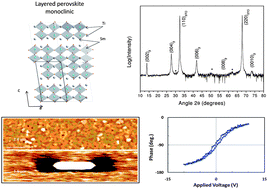 |
| The synthesis by the sol–gel route of metastable Sm2Ti2O7 thin film is reported. While for standard conditions of pressure and temperature, the Sm2Ti2O7 compound crystallizes in a cubic/pyrochlore structure, in the form of a thin film (grown on (110)-oriented SrTiO3 substrate), a monoclinic/layered perovskite structure is stabilized by strain effects induced by the substrate. Under these conditions, (00l)-oriented Sm2Ti2O7 oxide is isostructural to ferroelectric Ln2Ti2O7 (with Ln = La, Ce, Pr and Nd) phases, which is already well known. Studies by Selected Area Electron Diffraction (SAED) reveal the existence of a systematically twinned structure and the presence of a fault in the stacking of the perovskite layers. Piezoresponse Force Microscopy (PFM) measurements confirm undoubtedly the ferroelectricity in this metastable phase. |

- «Cyclodextrins as growth controlling agents for enhancing the catalytic activity of PVP-stabilized Ru(0) nanoparticles»
R. Herbois, S. Noël, B. Léger, L. Bai, A. Roucoux, E. Monflier, A. Ponchel
Chem. Commun. 2012, 48, 3451-3453 - doi : 10.1039/C2CC17355G - IF = 6,17
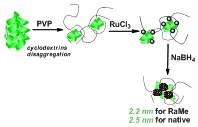 |
| Cyclodextrins act as growth controllers in the synthesis of PVP-stabilized Ru(0) nanoparticles, leading to enhancement of the catalytic activity in the hydrogenation of furfural. |

- «Cyclodextrin-Phosphane Possessing a Guest-Tunable Conformation for Aqueous Rhodium-Catalyzed Hydroformylation»
D. Ngan Tran, F.X. Legrand, S. Menuel, H. Bricout, S. Tilloy, E. Monflier
Chem. Commun. 2012 -48- 753-755 - doi :10.1039/C1CC16326D - IF = 6,17
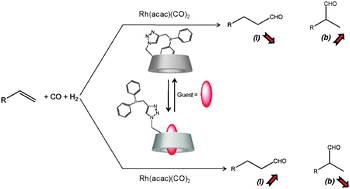 |
| The inclusion of a guest inside the cavity of a new water-soluble cyclodextrin–phosphane allows controlling the natural conformation of this ligand leading to an inversion of the regioselectivity during aqueous hydroformylation reaction. |

Faculté Jean Perrin - rue Jean Souvraz - SP 18 - 62307 Lens Cedex
tel : 03 21 79 17 05
fax : 03 21 79 17 55 |






